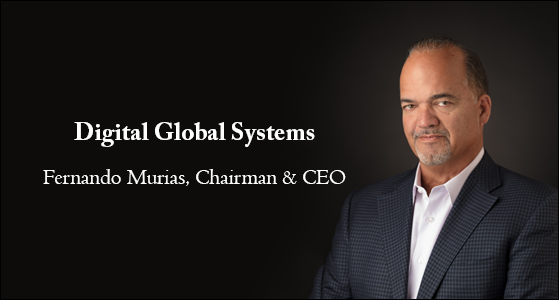30 Fastest Growing Companies to Watch 2024
CIO Bulletin

The development of LTE and 5G has stretched the boundaries of the Radio Frequency spectrum, which is a limited resource. Today, with the help of Radio Frequency Environmental Awareness, communication networks can be transformed, ushering in tomorrow’s 5G services.
Digital Global Systems (DGS) is a next-generation software provider that understands the impact and significance of transforming the wireless network industry. It is equipped with the efficiency, quality, and reliability necessary for the present and future of wireless environments. DGS analyzes Radio Frequency spectrums to create actionable data and insights specific to each industry.
CIO Bulletin talked to Fernando Murias, the CEO and Chairman of DGS, about the company’s growth and impact.
Q. How did Digital Global Systems (DGS) get its start? How has the company grown and changed since its inception in 2013?
Jeremy Levin, our current VP of Product Development, recruited me as the CEO. When I left PwC as the managing partner of the Washington, DC, office to join DGS, I first developed the business plan and capital raise strategy. I worked with the existing team to broaden the engineering footprint and bring structure to the organization. Since its inception, I have raised $100M to fund a robust R&D effort to develop a patent portfolio that will lead all firms globally in spectrum management.
We initially focused on automating functions like interference management for large wireless carriers. Since then, we’ve expanded into a more comprehensive solution for persistent spectrum monitoring and autonomous spectrum optimization, fitting squarely in the trajectory of 5G communications, dynamic spectrum sharing, and new wireless services that will drive the digital economy.
Q. How is DGS shaping the future of wireless technology?
We have developed market-leading technology that will:
Q. How has using this unique vantage point helped the company’s accelerated growth?
Our approach is to persistently monitor the wireless environment and characterize it at the point of intercept. The output is a highly robust and valuable data set of RF Environmental Awareness from which different stakeholders can extract actionable data. We are, first and foremost, a data company providing information that can characterize wireless signals in real-time to optimize spectrum more efficiently, enable more efficient resource allocations in the RAN, identify and mitigate interference sources, detect anomalous signals and RF threats, enable dynamic spectrum sharing, and ensure available bandwidth for new ultra-reliable/low-latency services. Our market-leading technology and strong patent positions have made us a valued strategic partner in capturing market share in the new digital economy. We are currently working with marquee RAN manufacturers, private wireless network integrators, and government agencies to deploy our solutions, proving the value of our RF data.
Q. How does DGS characterize radio frequency environments across multiple dimensions? Can you elaborate?
We evaluate power, time, frequency, location, and other signal characteristics to determine if disparate signals can coexist at the same frequency. We also identify various spatial characteristics. Due to its proprietary nature, that’s as much detail as we can discuss on this topic.
Q. How has real-time awareness of the spectral environment changed wireless network optimization?
Traditionally, carriers used KPIs inferred from the OSI model’s upper layers. Because we’re monitoring the physical layer in real-time, we’re providing ground truth, not inferred measurements. Real-time awareness enables signal rechanneling to avoid congestion and allows certain signals to coexist in the same frequencies. Providing information in real-time against defined customer goals has enabled the shift to a service-oriented environment from one that was driven by capacity constraints.
Q. DGS offers unique solutions meant to optimize today’s networks. What role has that played in helping DGS grow expansively in such a short amount of time?
Our unique solutions have enabled us to move from a hardware-centric to a software-centric solution. This has allowed us to move into a licensing and data-driven versus hardware-driven regime. This expands our revenue sources to RAN vendors, chipset companies, private wireless network providers, and government agencies globally.
Q. Can you talk more about DGS’ patented technologies? How is it helping the world achieve its anticipated low latency?
Understanding the spectral environment in real-time and applying our machine learning and AI capabilities enables our clients to determine whether applications requiring low latency or high reliability can be supported and which bands they should run, even in a shared environment.
Q. What are some of DGS’s future plans? How does the company plan to continue growing and expanding?
We now have 184 issued patents and expect to expand our coverage to new industries as satellite and suborbital devices become more prevalent in real-time communications. We also see an expansion of our technology into more government-oriented opportunities as border security and drone warfare become more prevalent. One of the pillars of the National Spectrum Strategy released last year is a focus on dynamic spectrum sharing. We anticipate additional licensing opportunities as more companies rush to implement dynamic spectrum-sharing solutions because we’ve been anticipating this move and building technology to support this, along with a patent portfolio to protect it.
About | Fernando Murias
Fernando Murias is the CEO and Chairman of Digital Global Systems. He graduated magna cum laude from the University of Maryland with a double degree in business and economics. He joined DGS in 2013, before which Fernando consulted on some of PwC’s most prominent clients while serving as the managing partner of the greater Washington, D.C. area and practice leader for a specialty group operating throughout Latin America and the United States. He was also responsible for starting and growing three distinct businesses within PwC.
Fernando’s 32 years of experience in public accounting were concentrated in the telecommunications and government contracting sectors. In his roles, Fernando has built significant enterprise business value using unique intellectual property portfolios and emerging data, analytics, and artificial intelligence innovations.







